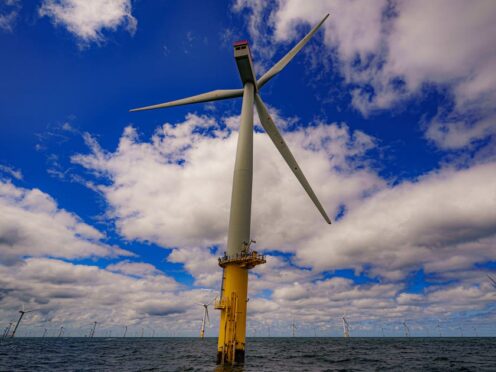
Developers are being offered £800 million in support for new offshore wind farms, as part of a record £1 billion backing for green power.
The Government has unveiled the cash pot for the next renewable electricity auction, which sees developers bid to secure a fixed price they can charge for each megawatt hour (MWh) of power they generate.
It also revealed there had been a delay to the competition to build small nuclear power plants – so-called small modular reactors (SMRs).
The boost for renewables comes after no companies submitted bids to build an offshore wind farm in the last auction round of the so-called Contracts for Difference (CfD) scheme last year.
The Government had already raised the ceiling for what companies could charge per MWh of electricity, which it said was necessary after inflation interrupted the trend where the price of renewable energy had fallen for years.

Now it has announced a cash pot for green electricity worth up to £1.025 billion, with the lion’s share – £800 million – for offshore wind projects delivered from 2027, and the remainder for schemes including solar farms, floating offshore wind and wave power.
The cost of the support will come out of energy bills rather than from general taxation.
But when overall electricity prices rise above the fixed price, wind farms could charge, as they have done during the energy crisis, with money being returned to consumers.
The move has been endorsed by the energy sector, but there are warnings more money will be needed to deliver on clean energy goals.
Industry body Energy UK’s chief executive Emma Pinchbeck said a big increase in the budget for the latest auction round “means investing more in homegrown sources of clean power that will bolster our energy security and reduce emissions – and bring wider economic benefits across the country”.
“While we still face an uphill battle to meet the 2030 target for 50 gigawatts (GW) of offshore wind, today has sent out an important signal in the face of growing international competition for investment and will help re-establish the UK as a leader in offshore wind.”
Keith Anderson, chief executive of Scottish Power, said the Government had made a major step in the right direction after last year’s auction failure by quadrupling the available budget.
He described it as “a clear statement of intent in ramping up the ambition to bring cheaper, greener energy onto the system quickly”.
He added: “I expect the auction to be hugely competitive. Given the scale of the available pipeline, there is always the opportunity to go further, and so we would encourage the Government to revisit the budget in the light of developments.”
But trade body RenewableUK’s chief executive Dan McGrail warned that the increase would not be enough to get the most out of the auction this summer.
“Although we welcome this budget increase, as it recognises that global economic conditions have changed, the Treasury has missed the opportunity to maximise the amount of offshore wind capacity which the UK could have secured in this year’s auction for new clean energy projects,” he said.
“We have more than 10 gigawatts of capacity eligible to bid in this summer. Building this is essential if we’re to make up lost ground from last year’s auction and create the substantial pipeline required to accelerate supply chain investment and growth in the UK. This funding will only secure between 3 to 5 gigawatts.”
In a Budget that was criticised by environmental groups and think tanks as failing to deliver the action needed to tackle the climate crisis, Jeremy Hunt also announced a £160 million deal with Hitachi to purchase two nuclear power plant sites.
The Wylfa site in Ynys Mon and the Oldbury site in South Gloucestershire could be used as sites for small modular reactors (SMRs), which supporters hope will be quicker and cheaper to construct than traditional nuclear power plants.
Great British Nuclear is running a competition for the selection of SMRs, and the Government said it was now moving to the next stage of the process with six companies invited to submit their initial tender responses by June this year.
But this is later than the timetable the Government set in October which said that by the spring it would announce which companies of the six had been chosen.
Tom Greatrex, chief executive of the Nuclear Industry Association said the purchase of the Wylfa and Oldbury sites was a “pivotal moment” for the future of nuclear in the UK.
“Wylfa is one of the very best sites for new nuclear anywhere in Europe and there is great promise for a series of SMRs at Oldbury.
“The success of ramping up nuclear capacity for energy security and net zero rests a great deal on whether we develop at these sites and others,” he said.
He also said he hoped the work on the next phase of the SMR selection process was “swift and thorough” so the UK did not fall behind other countries in delivering a nuclear programme.

Enjoy the convenience of having The Sunday Post delivered as a digital ePaper straight to your smartphone, tablet or computer.
Subscribe for only £5.49 a month and enjoy all the benefits of the printed paper as a digital replica.
Subscribe